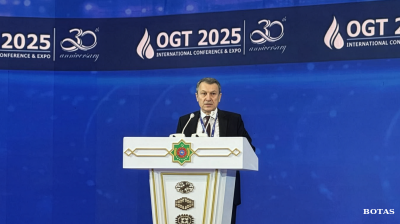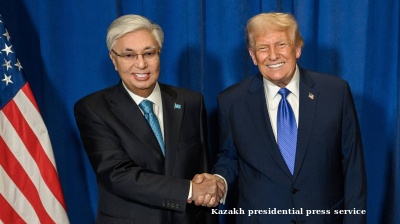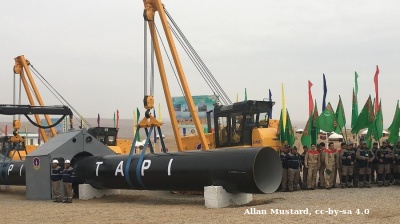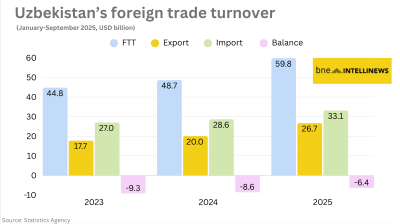The Navoi Mining & Metallurgical Combine (NMMC) is Uzbekistan’s crown jewel and the fourth largest gold mine in the world. It also epitomises the Central Asian republic’s efforts to modernise the economy and drag its businesses into the 21st century.
That challenge is literal, as the gold mine was set up in the 1950s in Soviet times and its management methods didn’t change much in the first few years after the fall of the USSR in 1991. This correspondent visited the mine in 1994 when it was similar to any large Soviet-era mono-city in the aftermath of the collapse; a giant enterprise that ran the city of Navoi, providing everything from work to nurseries and retirement homes as well as producing an extremely important source of foreign exchange for the improvised government.
Much has changed since then. Since Shavkat Mirziyoyev took over as Uzbek president in 2016 the mine has been steadily modernised, and work began in earnest several years ago to restructure the business and prepare it for a highly anticipated IPO that will bring in billions of dollars for the government.
“The first order of business was to strip out all the non-core assets – the schools, hospitals and the like. Crucially, the uranium mining business was separated into its own business, so now we are purely a gold producer,” Eugene Antonov, the first deputy general director of NMMC, told bne IntelliNews in an exclusive interview during the Tashkent International Investment Forum (TIIF) on June 13. “The company has been issuing IFRS accounts for the last four years and reassessed its asset base to international standards.”

"It’s a very exciting time now from an investment point of view. Uzbekistan is an alpha mining market," says Eugene Antonov, the first general director of NMMC.
Navoiuran is in charge of the uranium production and Uzbekistan is now a top five producer of the nuclear fuel and exports to customers particularly in Asia and Europe.
These changes have allowed NMMC to make its first forays into the international capital markets, both to raise investment capital, but also as a “get to know you” exercise as Uzbekistan opens up to the rest of the world after decades of being a hermit nation under the previous president, Islam Karimov.
The ratings agencies awarded NMMC its first long-term credit rating of 'BB-' in July 2024 with a 'Stable' outlook, matching Uzbekistan's sovereign credit rating, and a few months later NMMC issued its first bond.
“Our rating was on a par with the sovereign rating, but on a standalone basis it was two notches higher, which demonstrates the confidence of investors that the company can meet its obligations,” says Antonov.
NMMC issued its debut $1bn Eurobond in October last year. The bond was a dual-tranche offering: $500mn in 4-year notes with a 6.70% yield and another $500mn in 7-year notes at 6.95%. The funds raised are being used to support NMMC's investment plans, which include expanding its gold production and furthering strategic projects.
The company followed up with a second issue of $500mn earlier this year that was likewise two times oversubscribed.
Part of the money was ploughed back into improving operations and the company achieved an ambitious goal to increase gold production by just under a third (30%) in 2024 – a timely investment as the growing global instability has driven up gold prices to new all-time highs over $3,000 per ounce.
NMMC’s ongoing investment programme includes a $281mn investment to increase ore processing capacity as part of the company’s broader goal of reaching 100mn tonnes of annual processing capacity, making it the fourth largest producer in the world as well.

National importance
The mine is huge. Its main asset is the Muruntau open-cast gold mine in the Kyzyl-Kum desert that is so big it is visible from space. Initially the mine was established in 1958 to produce uranium to support the USSR’s nuclear ambitions, but over time the plant expanded its operations to include gold mining, positioning itself as a major player in the global gold market. By the late 1960s and early 1970s the combine had established itself as a key source of minerals not just for the USSR but also as a player on the world stage. The mine got a new lease of life in 2016 after President Mirziyoyev took over and began a $3bn investment programme.
Uzbekistan has been putting 6.5% rate of growth a year for the last five years and 15% of that is just from mining, with NMMC accounting for 6.5% of Uzbekistan’s GDP by itself. And despite its size, Antonov says the combine has literally only scratched the surface of Uzbekistan’s potential mineral resources.
“It’s a very exciting time now from an investment point of view… Uzbekistan is an alpha mining market as there is still so much to be found; only a third of the country has been geologically surveyed and the Kyzyl-Kum desert barley at all,” Antonov said excitedly, who has spent his whole working life working for mining companies around the world before returning to his native Uzbekistan to run NMMC.
Besides gold and uranium, Uzbekistan has considerable deposits of copper, molybdenum, silver, lead, zinc, tungsten and the 17 rare earth elements. The Almalyk Mining and Metallurgical Combine (AMMC) is the main producer of copper and other base metals.
Exploration efforts have intensified in recent years and the government has been investing heavily into its mineral and metallurgical sector as it is well aware of the country's potential. The whole county is being surveyed now as the country becomes one of the fastest-expanding mining markets in the world. More recently, it set up the Technological Metal Complex (TMK) specifically to look for and exploit deposits of critical minerals and rare earth metals.
Muruntau is a massive operation with a production capacity exceeding 60 tonnes per year (tpy) of gold. This makes it one of the most productive mines globally, contributing significantly to Uzbekistan’s status as the world’s eighth-largest gold producer.
“We have twelve large mine sites and nine processing facilities” Antonov. “Muruntau mine is the largest open pit in the world. It can be seen from space. 70% of our resources are there and 50 years’ worth of resources in total.”
The quarry itself stretches 3.3 km in length and 2.5 km in width, with a depth exceeding 600 metres. The production is managed through advanced technological systems, ensuring efficiency in mining and processing. In 2022, the NMMC produced over 94 tonnes of gold, generating substantial revenue for the Uzbek economy.
And it is very profitable. Antonov explains that it also has the lowest production costs in the world.
“Last year we achieved our goal of increasing production by 30% to earn $7.4bn in revenues and EBITDA of $4.5bn with a margin of over 60%. Our costs of only $979 per ounce – the second lowest in the world after Polyus in Russia,” Antonov said.
The plant is being prepared for privatisation and has hired a number of international consultants to prepare it for a widely anticipated IPO, Nikolai Snitka, the ebullient chief engineer of Navoi Gold, told bne IntelliNews in an extensive interview at the mine in 2021.
The gold mine has been through four stages of development since it was founded and a fifth development phase is currently underway, due to finish in 2026.
The company has already been reorganised into a joint stock company in preparation for privatisation and a new board of directors appointed, with two new independent directors appointed last year to improve transparency and as part of its preparations for privatisation. The consultants have been rationalising the books and bringing the corporate practices up to international levels of corporate governance and transparency before a potential listing.

ESG
The NMMC is not only a significant contributor to Uzbekistan's GDP but also one of the largest employers in the country, a key consideration for a country with the fastest growing population in the Former Soviet Union (FSU). And Soviet industry is not well known for its concern with the environment. ESG has become a core part of the company’s overhaul, says Antonov.
“ESG has also become an important part of the company’s strategy with an ESG strategy and annual reports,” says Antonov. “We had an ESG rating from Sustainable Fitch and we were pleased to see our ranking was already on a par with our mining peers.”
NMMC provides jobs to tens of thousands of workers in the Navoi region, including engineers, miners and various other specialists, and with the government’s focus on providing work for the country’s burgeoning young population, NNMC is also focused on catering to the needs of its workforce.
“We have 47,000 workers, we are the largest contributor to the budget as well as accounting for 6.5% of GDP. That means we don't just have an obligation to the shareholders, but also to be a sustainable producer and for the benefit of the people of the country,” says Antonov. “We engage actively with our community – including the management. I regularly meet with the community to listen to their concerns and needs. Last year we spent over $200mn on community projects. All our investment efforts aimed at increasing the well-being of our people.”
Antonov has introduced an ESG code and publishes annual sustainability reports. NMMC is investing into renewables and plans to produce 21% of its power needs using solar and wind power by 2026. It also has a water use reduction programme – a key issue in the arid deserts of Uzbekistan – that will save some 36bn cubic metres of water by 2030.
“Mining is perceived to be environmentally unfriendly across the world. Most mines, including us, are working to change that stereotype. Now issuing emission targets and following those targets. And we are also exploring new energy resources so that by the end of this year 20% of our total energy consumption will come from renewables,” says Antonov. “We were the Uzbek company to get an ESG rating from Fitch with entry level 3.”
Features

Slovenian consumers take energy giant GEN-I to court over price hikes
The Slovene Consumers’ Association accused GEN-I of unlawfully raising household prices at the height of the recent energy crisis.

Indonesia's $12bn stimulus play
The coordination between the Finance Ministry and the presidency signals tighter executive cohesion under President Prabowo’s leadership, contrasting with the cautious fiscal stance of prior administrations.

COMMENT: For Asia, dealing with Europe isn’t about achieving success; it’s about concealing failure
To be taken seriously in Asia, Europe must rediscover the courage to deliver, not merely declare. Asia has moved on to execution. Europe is still editing its initial policy draft.
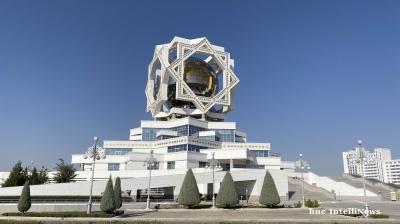
Washington has a new focus on a Caspian energy play
For most of the last three decades since winning independence, Central Asia has been a bit of a backwater. Not any more. The Trump administration is becoming more focused on Turkmenistan's vast gas reserves and can smell money and power there.
